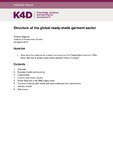| dc.contributor.author | Megersa, Kelbesa | |
| dc.date.accessioned | 2019-09-19T12:06:18Z | |
| dc.date.available | 2019-09-19T12:06:18Z | |
| dc.date.issued | 2019-08-22 | |
| dc.identifier.citation | Megersa, K. (2019). Structure of the global Ready-Made Garment sector. K4D Helpdesk Report. Brighton, UK: Institute of Development Studies. | en |
| dc.identifier.uri | https://opendocs.ids.ac.uk/opendocs/handle/20.500.12413/14705 | |
| dc.description.abstract | The ready-made garment (RMG) industry’s value chain is buyer-driven. It is labour intensive and involves large retailers who have specific product requirements. Large companies set up production plants in regions where land and labour are cheaper. Clothes are then shipped, largely to western markets but increasingly Asian markets also. Business models can be vertically integrated or more focussed on outsourcing. A vertically integrated model is where one company owns and is responsible for all parts of the supply chain. An outsourced model is where a company outsources different parts of production to others in the supply chain. Key RMG industry players are often a mixture between these two models. Although outsourcing can be more cost-efficient in terms of production costs there are trade-offs. The complexity of coordinating arrangements can be costly and slow. Increasingly, consumers are wanting more complex items and at an instant rate with changing fashions and trends. More integration can improve production lead times. A number of case studies provide some insight into sourcing and management practices: VF Cooperation, PVH, Inditex, Li Fung & Fosun International. A country case study looks at Lesotho describes two value chains. One involving Taiwanese owned factories producing for the US market, and one involving South African owned production plants exporting back to South Africa. Taiwanese production plants focussed more on basic production and have relationships with locals are less integrated. South African owned production hired more local supervisors and managers and provide more training. Changing regional and international trade agreements are a significant factor for companies making decisions on where to locate production plants. For example, the African Growth and Opportunity Act provides sub-Saharan African exports duty- and tariff- free access to the US RMG market and has attracted Asian investors into Africa. Power relations in the value-chain are often skewed where production plants are reliant on demand from big companies who are connected to the markets. The larger retails companies or supply chain managers are less reliant on the small producers of which they have a choice in the global landscape. The McKinsey State of Fashion Report 2019, emphasises the need for global players to become more agile and able to respond quickly to consumer demands for changing fashions. Greater integration of supply chains lends itself to shorter lead times. The report also notes emerging demand for ethical products and company practices as younger consumers are increasingly conscious of environmental and social issues. | en |
| dc.language.iso | en | en |
| dc.publisher | IDS | en |
| dc.relation.ispartofseries | K4D Helpdesk Report;641 | |
| dc.rights.uri | https://www.nationalarchives.gov.uk/doc/open-government-licence/version/3/ | en |
| dc.subject | Industrial Development | en |
| dc.subject | Trade | en |
| dc.title | Structure of the Global Ready-Made Garment Sector | en |
| dc.type | Helpdesk | en |
| dc.rights.holder | © DFID - Crown copyright 2019 | en |
| dcterms.dateAccepted | 2019-08-22 | |
| rioxxterms.funder | Department for International Development, UK Government | en |
| rioxxterms.identifier.project | K4D | en |
| rioxxterms.version | VoR | en |
| rioxxterms.funder.project | 238a9fa4-fe4a-4380-996b-995f33607ba0 | en |

